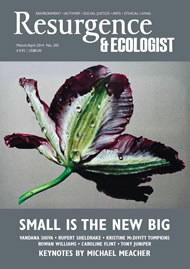Anne Middleton’s vision of the natural world overflows with sensual delight. It is lush, rich, fecund, playful, compellingly detailed, subtly interconnected, and touched with a very definite sense of magic.
She paints large – or, at least, large-ish – canvases (96cm x 126cm), depicting pieces of fruit, flower blooms, insects, birds and other creatures, all in exquisite close-up.
Each image is a ringing testament not just to close observation and great technical skill but also to a deep love of Nature. They are full of understanding of the natural world, its tiny marvels and its everyday mysteries. There is a readily communicated pleasure in the shifting colours and textures of ripe cherries, or dew-speckled strawberries or bumblebee wings, or passion-flower stamens. For all this Middleton reaches back to what she describes as an “idyllic” Australian country childhood, growing up in the Dandenong Ranges outside Melbourne amidst pockets of ancient rainforest, fern-shaded freshwater springs, and profusions of springtime blossom.
But she is no mere recorder of the natural world. She is neither a traditional botanical artist nor a conventional photorealist. Her art is full of surprises for the viewer. Her motifs are not fixed in any naturalistic context. Each element is distinct, or nearly so, seeming to float free against a background of bare Belgian linen. There are startling tricks of scale: an ibis perches upon a cherry. There are surreal juxtapositions: a fish intrudes amongst a bunch of grapes.
The intensity of her vision creates a sense of worlds concealed within worlds. “Look into the translucent skin of a plump cherry,” she says “and see the colours swirl and become an apocalyptic sunset where clouds explode like fireworks across the sky; a luscious strawberry reveals strange orbs hovering in the atmosphere of its belly.”
For her latest body of work, Gates of Paradise, executed over the last five years, the canvases were conceived as an open-ended series, with each one connecting to the next to create what she describes as “a massive jigsaw”. Although the paintings all work (and can be bought) individually, the underlying sense of all things relating to – and being part of – a whole is important to Middleton’s artistic philosophy. As the Wall Street International noted, the effect is “to form an enduring visual statement that is both overwhelming and all encompassing in scale” – and one by which “we are confronted with and inspired to reconsider our impact on this fragile planet.”
The essential modernity of Middleton’s vision is counterbalanced by an exceptionally deep knowledge of traditional painting techniques. Through long study and training she has become a virtuoso in the use of paint. She has learnt from the painters of the Italian Quattrocento and the mid-17th century. She has made detailed studies of how Andrea del Sarto and Jean-Baptiste-Siméon Chardin achieved their varied effects.
She has a huge, and very proper, respect for technical mastery, in any medium – not as a virtue in itself but as a means to full expression. “Intellectually, emotionally and spiritually,” she explains, “a true master can suggest the most precise detail with the least expenditure of effort.”
She is the child of artists. Her father, Max Middleton (1922–2013), was a noted Australian plein-air landscape painter who had studied in Europe during the 1950s. And although he never gave her any formal lessons, she was able to learn much from watching him, working alongside him, and plaguing him with questions. She acknowledges that it was from him that she learned “everything I needed to know about the process of making an oil painting”.
To this understanding she added an arts and crafts degree at the University of Melbourne, which, unlike so many modern art-school degrees, had a strong technical emphasis. Then there were two formative stints studying in Italy. She attended the Laboratorio per Affresco di Vainella, where she mastered the traditional Renaissance painting techniques of fresco and egg-tempera painting. And in 2004 she was awarded a fellowship at the prestigious Bogliasco Foundation in Genoa. It was there that she developed her enduring fascination with the oil-glazing techniques used by the painters of the Baroque period.
It proved a revelatory experience. The possibilities offered by the technique were perfectly matched to her vision. By building up coloured oil-glazes in transparent layers, she found that she was able to achieve incredible levels of luminosity in her work. Light became the element in which everything in her artistic universe exists. Light seems almost to radiate from the painted images. And it is this that gives Anne Middleton’s work its compelling intensity: that sense of the vital importance, the magic and the connectedness of every part of creation.








